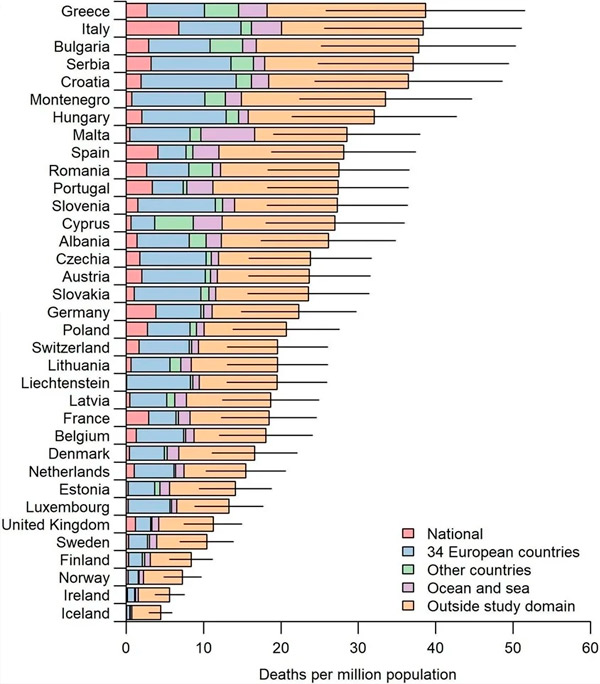Transboundary ozone pollution significantly increases mortality rates in Europe
Last reviewed: 14.06.2024

All iLive content is medically reviewed or fact checked to ensure as much factual accuracy as possible.
We have strict sourcing guidelines and only link to reputable media sites, academic research institutions and, whenever possible, medically peer reviewed studies. Note that the numbers in parentheses ([1], [2], etc.) are clickable links to these studies.
If you feel that any of our content is inaccurate, out-of-date, or otherwise questionable, please select it and press Ctrl + Enter.

In a recent study published in Nature Medicine, researchers identified the geographic sources of ozone air pollution and estimated ozone-related mortality rates in Europe.
Ground level ozone is formed in the troposphere by the interaction of sunlight and greenhouse gases (GHGs) emitted from both natural and anthropogenic sources, especially nitrogen oxides and volatile organic compounds.
Ground-based ozone is a very harmful air pollutant. It is associated with many respiratory complications, including asthma, chronic obstructive pulmonary disease, and lung infections. Moreover, overexposure to ozone is the leading cause of air pollution-related hospitalizations and premature deaths worldwide.
According to the European Environment Agency, more than 95% of the European population is exposed to ozone levels exceeding air quality guidelines set by the World Health Organization (WHO).
Tropospheric transport of ozone and its precursors from distant sources, otherwise known as imported ozone, is a major determinant of ground-based ozone levels. Therefore, concerted action between countries is needed to effectively reduce ground-based ozone levels and associated health complications.
In the current study, scientists assessed the health effects of ground-based ozone exposure in Europe. They also quantified the mortality rate associated with both domestic and imported ozone in 813 contiguous regions of 35 European countries, representing 530 million people.

O3 levels and associated mortality during the warm season (May–September) 2015–2017
a. Average daily maximum 8-hour O3 value (μg/m³).
b. Mortality rate (annual deaths per 1 million population) due to O3.
a,b. Histograms display both a color legend and the number of regions for each value.
The average concentration of ground-based ozone in European countries was estimated at 101.9 µg/m³. Ozone concentrations in southern European countries were higher than in the north, which can be explained by the warmer climate of this region.
In the warm seasons of 2015-2017, 72 annual deaths per million inhabitants were reported. The highest mortality rates were recorded in densely populated and south-eastern European countries.
About 88.3% of all ozone-related deaths were caused by exposure to imported ozone, with a cross-country range of 83-100%. Hemispheric sources were the main contributors to imported ground-based ozone, which was responsible for 56.7% of all ozone-related deaths.
Exposure to imported ozone produced by other European countries was responsible for 20.9% of all ozone-related deaths. Imported ozone from oceanic and marine sources also contributed to 7.2% of all deaths in smaller southern European countries.
The most populous and industrialized countries were the major contributors to deaths associated with imported ozone. Significant effects of ozone originating in France have been noted on mortality in neighboring countries including Luxembourg, Switzerland, Belgium, Liechtenstein, Spain and Germany. Similarly, ozone from Germany significantly affected mortality in Luxembourg, the Czech Republic, the Netherlands, Denmark, Austria, Belgium and Poland.

O3-related mortality by O3 emission sources in 35 European countries 2015–2017. Only those days when the average daily maximum 8-hour O3 value exceeded 70 μg/m³ were included in the analysis. The horizontal bars represent the 95% empirical confidence interval of the total mortality due to O3 (i.e., the sum of the contributions from the five sources).
In southwestern countries, the impact of transboundary ozone transport was less pronounced. The highest mortality rates due to national ozone production were recorded in Spain, France and Portugal.
A sensitive analysis assessing ozone-related mortality at a safe threshold of 70 µg/m³ showed a threefold reduction in the number of deaths to 23 annual deaths per million inhabitants in the warm seasons of 2015-2017.
The wide-scale geographic coverage of the current study allowed the researchers to determine the impact of ground-based ozone on overall mortality across the continent. The greatest burden of mortality in Europe was associated with hemispheric ozone transported from other countries. In comparison, only a small proportion of deaths were associated with ozone production at the national level.
Ozone transported from other European countries also has a significant impact on mortality. A significant contribution of ozone emissions from marine sources to mortality has been noted in some coastal regions and small Mediterranean countries.
The study highlights the need for transboundary assessment of pollution sources and associated health impacts for effective air pollution management. However, most current mitigation efforts are focused at the national and regional levels.
The observed impact of emissions from marine sources on mortality highlights the need for nitrogen control zones to reduce nitrogen oxide emissions, which has been successfully implemented in the North and Baltic Seas.
Current forecasts indicate that global warming may increase ground-based ozone levels. In addition to directly triggering ozone production, global warming may also increase emissions of ozone precursors, which may further contribute to overall tropospheric ozone concentrations. Therefore, climate change mitigation is essential to improve air quality and reduce the health impacts of air pollution.
Taken together, the study's findings highlight the need for national or coordinated pan-European action and global strategies to reduce the deadly effects of ozone.
